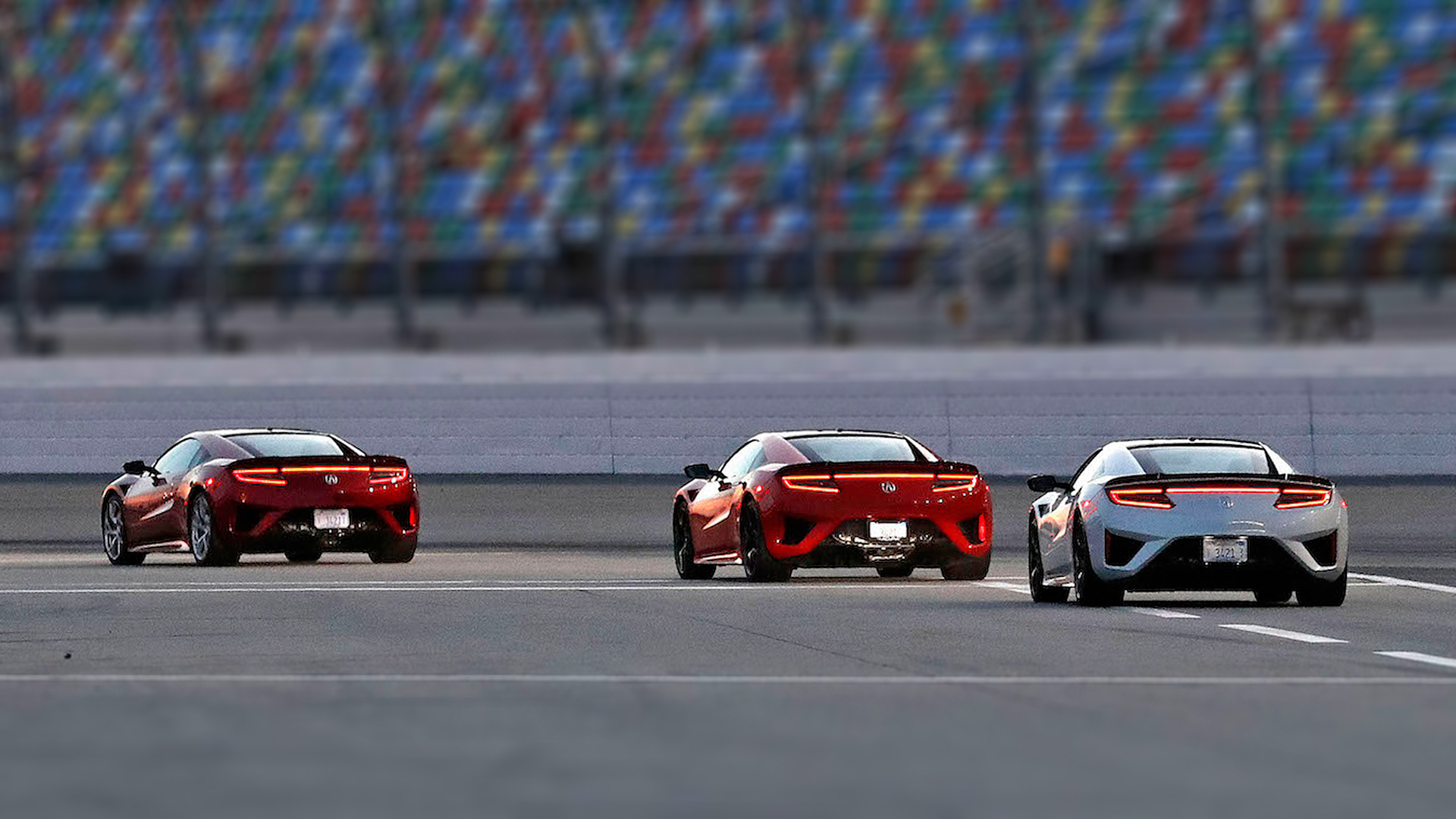I may not have been ready to drive the 2019 Acura NSX along 31 degrees of banking in the dark. In case you’ve never attempted this sort of driving, this feels roughly like you’re driving on the side of a wall at triple-digit speeds. Your eyes constantly try to adjust to this bizarre new reality, and your brain screams “Why are you doing this, body?“
Driving any car at Daytona International Speedway’s 3.56-mile road course, which features the great majority of the NASCAR tri-oval plus the inner road course, isn’t exactly a breeze for first-timers. Yet, there I was during a break in the action at the Rolex 24 Hours, suited and booted and trying to squeeze into my red, 573-horsepower Acura NSX—and I was about to find out if more than 10 years of driving the track on Forza Motorsport were enough to keep me from making an idiot out of myself.


Before I had time to snap a squished-helmet-face selfie, IndyCar superstar and Jean Girard impersonator Simon Pagenaud put the hammer down and blasted out of the pits, which were already decked out with Team Penske Acura signage for the Rolex 24 Hours. Behind Pagenaud was Art St. Cyr, the highest-ranking man at Honda Performance Development (HPD). Then came me, then, wrapping up the quartet of American-built supercars, was regular The Drive contributor Stef Schrader. No pressure.
Once Track Mode and manual shifting were engaged, the NSX’s digital tachometer turned bright red, while the traction control warning light—a tiny picture of a car skidding out of control—orange. (Big confidence boost.) Before I could process the implications, I clicked the right paddle and took off.


My first surprise was just how narrow pit exit was; if the street-going NSX felt wide through there, I couldn’t even imagine how Katherine Legge felt in her aero-crazy NSX GT3. The pit exit spits you out into Turn 3, a tight 180-degree right-hander called the “Horseshoe,” which gives way to a series of flowing, fast turns leading to the first oval section. I made quick work of these during the installation lap, getting used to the NSX’s lightning-fast gear changes and the track’s cold surface (it was a chilly 50 degrees).
However, the confident look was quickly wiped off my face when I hit the first road-course-to-oval transition. Expletives and animal sounds flew from my mouth as I hit the banking for the first time. I spent my teenage years racing in national-level karting championships; I’ve driven a dual-engine, 250cc shifter kart at Road Atlanta at more than 115 miles per hour; I’ve thrashed a Corvette Grand Sport around Indianapolis Motor Speedway. But compared to Daytona, all of the above was child’s play.
I knew better than to touch the NSX’s 7,500-rpm redline on the first lap, as I aimed to accelerate the process of becoming acquainted with the dynamics of the car, the tires, brakes, the whole enchilada. While the cars in front of me went high on the oval, moving what seemed like way too close to the wall, I remained in the middle; it was just too scary, too soon. We quickly hit the Bus Stop chicane and returned to the oval, successfully crossing the finish line for the first time at around 120 mph.


The second lap was better. I pressed the 3.5-liter twin-turbocharged V6 for more; my brain had finally processed that the all-wheel-drive system and three electric motors made rocketing out of corners an easy task. By the time I arrived at the banking for the second time, I felt more comfortable keeping up with the Acuras in front of me, driven by people who had obviously done this more than I. Before I knew it, I was poking a hole in the air at about 130 mph before asking the six-piston Brembo brakes to clamp down on the 15-inch carbon ceramic rotors up front as I dove into Turn 1, a taxing corner that forces the driver to brake while turning. The double-wishbone front suspension and multi-link rear boast magnetorheological dampers all around; even when physics pulled me toward the run-off, the NSX kept its nose down and went where desired.

The fast and flowing section after the Horseshoe was simply too technical to effectively string together in a 10-minute session—especially at night, when braking and turn-in references were nearly impossible to establish. The other sections, though, I was able to dance through them with a smile on my face by the end of the quick series of laps. I was far from perfection—hell, far from mediocrity, by Pagenaud’s standards—but I’d like to think I rocked it. Perhaps that’s the most impressive quality about the NSX (or maybe the second, following its easy-going character on the street): the fact that it makes you feel like you can keep up with an IndyCar driver on track. Even if, in reality, Pagenaud was drifting through corners with ease, while I was hanging on for dear life.
